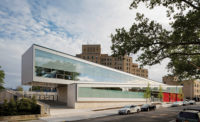Last October, some 30,000 Toronto residents descended on the Bentway, the city’s newest urban park, to experience a nighttime illumination by Dutch designer Daan Roosegaard that rippled like an oceanic current overhead. Titled Waterlicht, the LED projection was a poetic way of bringing awareness to rising water levels.
It’s hard to imagine Waterlicht’s happening at that spot a few years ago. For decades, this mile-long ribbon of unused land—the underbelly of the elevated Gardiner Expressway that aggressively cuts the downtown core from its prized lakeshore—was a virtual dead zone to everyone but the homeless and vandals. The turnaround was sparked by the thinking of urban planner Ken Greenberg of local firm Greenberg Consultants, who envisioned its potential as a kind of shared backyard for the high-rises springing up around it. He brought the idea to philanthropists Judy and Wilmot Matthews, who jump-started the project by donating $19 million. Now a charitable organization, the Bentway receives additional funding from the federal and city governments to help with maintenance and to support a robust all-season program of activities and events.
Designed by local landscape architecture firm Public Work, the 10-acre site links seven neighborhoods, home to approximately 70,000 condo dwellers. Principal Marc Ryan describes it as “the knuckle,” where pathways for pedestrians and cyclists connect to a host of formerly disjointed public assets, including the CN Tower and Fort York National Historic Site to the north and Harbourfront and Lake Ontario to the south. “It’s very porous,” says Ryan. “There’s really no front door—you can enter the park from any direction.”
Officially opened in January 2018, the park is by no means showy. Instead, Public Work implemented minimal interventions, many of which will hardly be noticed—for example, the design team flattened topography and bulldozed landfill into grassy knolls to create areas for seating and picnics. The main feature is a 700-foot-long ice-skating loop, already so popular that, on weekends, skaters shuffle rather than glide around its figure eight form (though no one seems to mind); in the summer, the rink becomes part of the path network. The most recent addition is a small terrace with a half-dozen rows of timber bleachers for audiences to watch outdoor performances or film screenings. More phases, including the construction of a suspended pedestrian bridge, are planned, although they have not yet been fully funded.
In keeping with the understated aesthetic, amenities are either made from salvaged or off-the-shelf materials and are designed to be as durable as possible. Picnic benches, for instance, are mounted on wheels for easy maneuvering, and the walkways are a composite of asphalt, porcelain, and glass bottles reclaimed from a local landfill. During an early morning tour, Ryan pointed out over 1,000 feet of ¾-inch steel cables strung overhead, clamped to the Expressway’s towering support columns as theater rigging that can bear up to a ton of weight, for suspending various objects and event props.
By far the Bentway’s most striking feature is what was already there: those 55 soaring concrete columns (also known as “bents”) that support the highway, which Public Work has left unadorned, adding only giant gold-stenciled numbers to each for wayfinding. With their heights reaching as tall as five stories, the bents are magnificent expressions of an earlier era, and the park a stellar example of urban reinvention. What was once a forgotten strip of land now offers strollers en route to the lake a protective rooftop that buffers sound, rain, sun, and snow.





Post a comment to this article
Report Abusive Comment